

Online publication for school educators. Research into highly effective schools has consistently highlighted the importance of effective teaching methods.
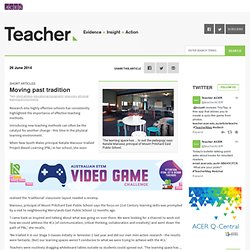
Introducing new teaching methods can often be the catalyst for another change - this time in the physical learning environment. When New South Wales principal Natalie Mansour trialled Project-Based Learning (PBL) in her school, she soon realised the 'traditional' classroom layout needed a revamp. Mansour, principal of Mount Pritchard East Public School says the focus on 21st Century learning skills was prompted by a visit to neighbouring Merrylands East Public School 12 months ago. 'I came back so inspired and talking about what was going on over there. We were looking for a channel to work out how we could address the 4Cs [of communication, critical thinking, collaboration and creativity] and went down the path of PBL,' she recalls. 2014-05-15-eight-ways-to-build-blended-learning-class-culture?utm_content=buffer276f9&utm_medium=social&utm_source=twitter. If students don’t care about the quality of work they produce online, everything they do online loses its value: the websites or apps they use, the data collected.

Nothing can be utilized with fidelity if students are half present when they are online. That's why while giving a tour of our learning labs at Ranson IB Middle School, I was struck by an extremely important question I don't get asked very often. One of the teachers asked me, “How do you build the culture around Blended Learning so that students will put as much care in the work they do online as they put in the one they do in class?” I would lie if I said I can guarantee that at any given time 100% of our students are giving it 100% online. We still have a lot of room to grow. 1. Figure out, what it means for students to work effectively and independently online without the constant guidance of a teacher. 2. 3. 4. Too often, we rely only on the raw data given by a tool to measure our students’ understanding of a concept. 5. PBL: Managing the Mushy Middle.
Yesterday I had the privilege of spending the day with 30 extraordinary educators.
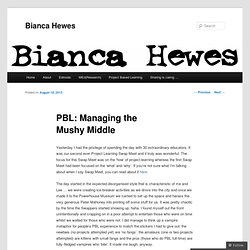
It was our second ever Project Learning Swap Meet and it truly was wonderful. The focus for this Swap Meet was on the ‘how’ of project-learning whereas the first Swap Meet had been focused on the ‘what’ and ‘why’. If you’re not sure what I’m talking about when I say Swap Meet, you can read about it here. The day started in the expected disorganised style that is characteristic of me and Lee … we were creating ice-breaker activities as we drove into the city and once we made it to the Powerhouse Museum we rushed to set up the space and harass the very generous Peter Mahoney into printing off some stuff for us. It was pretty chaotic by the time the Swappers started showing up, haha. Australian landmarks photo set (SB9254) Project-Based, Problem-Based, or Inquiry-Based Learning? Project-Based Learning: Real-World Issues Motivate Students. Concrete, authentic project-based learning helps students illustrate core knowledge.
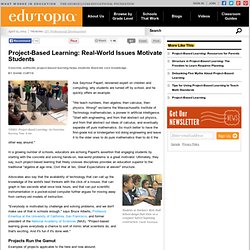
VIDEO: Project-Based Learning: An Overview Running Time: 9 min. Ask Seymour Papert, renowned expert on children and computing, why students are turned off by school, and he quickly offers an example: "We teach numbers, then algebra, then calculus, then physics. Wrong! " In a growing number of schools, educators are echoing Papert's assertion that engaging students by starting with the concrete and solving hands-on, real-world problems is a great motivator. Students at Harlem's Mott Hall School design their kites on a computer before beginning construction. Credit: Edutopia Advocates also say that the availability of technology that can call up the knowledge of the world's best thinkers with the click of a mouse, that can graph in two seconds what once took hours, and that can put scientific instrumentation in a pocket-sized computer further argues for moving away from century-old models of instruction.
Edmodo: The Classroom Hub for Project-Based Learning. FRONT ROW SEAT Edmodo is becoming an indispensable tool in many classrooms engaged in project based learning, to help with project management and assessment.
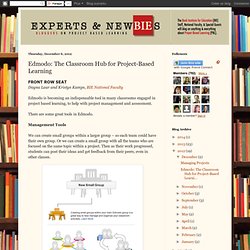
There are some great tools in Edmodo. Management Tools We can create small groups within a larger group – so each team could have their own group. Or we can create a small group with all the teams who are focused on the same topic within a project. Then as their work progressed, students can post their ideas and get feedback from their peers, even in other classes. The Library allows us to share links and documents with students. The latest version of Edmodo has “backpacks” where students can organize and store their own resource materials. The calendar allows the teacher to lay out the steps and due dates. Feedback and Assessment. Simplify Project Based Learning With Biteslide. Introduction In this article I shall give you a brief introduction to Project Based Learning (PBL) and show you how Biteslide can be used as an end-to-end technology solution for PBL projects.

There are a dizzying number of EdTech tools on the market today. Some are quite good and can give you a significant return on your time investment, others aren’t so good, and will lead to wasted time and frustrated students. Using an end-to-end solution simplifies the integration of technology and keeps the focus where it should be, on the project. 11 Essential Tools For Better Project-Based Learning - Getting Smart by Guest Author - blended learning, EdTech, PBL.
“11 Essential Tools For Better Project-Based Learning” by Katre Laan from myhistro.com first appeared on TeachThought.
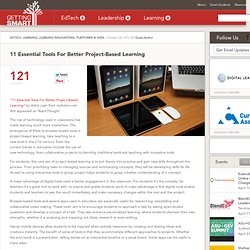
The rise of technology used in classrooms has made learning much more interactive. The emergence of iPads to browser-based tools in project-based learning, take teaching to a new level in the 21st century. Even the current trends in education include the use of new technology, from collaborative projects to blending traditional textbook teaching with innovative tools. For students, the core aim of project-based learning is to put theory into practice and gain new skills throughout the process.
From prioritizing tasks to managing sources and summarizing concepts, they will be developing skills for life. A major advantage of digital tools used is better engagement in the classroom. Giving Students Meaningful Work:Seven Essentials for Project-Based Learning. Project Based Learning – giving it a go in an English Classroom. I’ve been reading about Project Based Learning for some time now, and struggled trying to find a way to integrate this kind of pedagogy into my regular classroom practice.

I think I do a fairly good job of challenging my students and getting them to think beyond the obvious, but my English classes do tend to follow what would be perceived as traditional structure. This last term we studied Shakespeare’s Romeo and Juliet. We did make a decision early on to plan the unit using the principles of Understanding by Design, and this meant we had a driving question to help us focus. Our question was, ‘What drives the choices we make?’ It took us some time to get to this question in one of our planning sessions, but I’m so glad we went to the effort of doing this. For the last two weeks of term, we’d decided that we would try and have them do something creative in response to Romeo and Juliet, and have them work on a multimodal task as per the requirements of Australian Curriculum.
The Difference Between Projects And Project-Based Learning. The Difference Between Projects And Project-Based Learning by TeachThought Staff Projects in the classroom are as old as the classroom itself.

“Projects” can represent a range of tasks that can be done at home or in the classroom, by parents or groups of students, quickly or over time. An Inside Look At How Project-Based Learning Actually Works. Project-based learning is one of the most popular terms in education innovation today.

We talk about PBL all the time and how it, combined with flipped classrooms, can basically change the way education works. It’s an exciting time to be sure. But I love to actually see how this kinda stuff works in real life. Apps for Project-Based Learning.